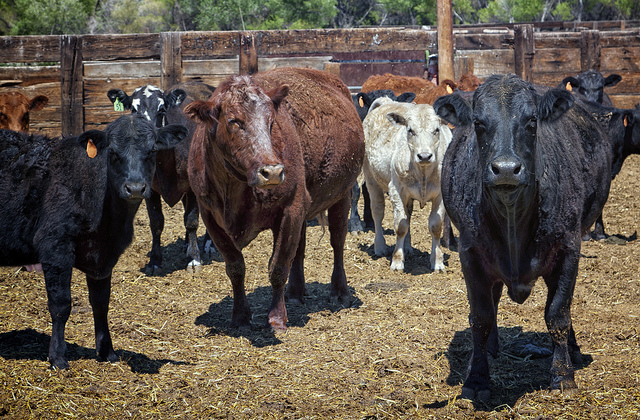Podcast: Play in new window | Download
Subscribe: RSS

Far from the fields of grass they once roamed, and on which they evolved, cows such as these — sick, crowded, dirty, stressed, being force fed unnatural food and shot up with chemicals — are the source of today’s T-bone steak. (Photo by Randy Heinitz/Flickr)
It is possible to gag a hyena; the food industry has actually choked on its own latest solution to an economy-of-scale problem. The problem was created when the corn industry mandated (through its wholly owned subsidiary, the United States Congress) the use of corn ethanol in automobile fuel. Among the unintended consequences were an immediate tripling of the cost of corn, leading to 1) widespread famine in countries whose staple food is the tortilla, and 2) more importantly, decreased profits for cattle feedlots. The feedlots demanded, and got, a quick fix: a chemical that would reduce the amount of corn needed to fatten cattle by making them swell up. Oddly, not everything worked out well.
The solution — and the new problem — was a drug originally known as Zilpaterol, a beta-2 agonist used to dilate the bronchial passages of asthma sufferers. It fell out of favor when it turned out that it also altered metabolism to favor muscle formation instead of fat (like steroids, or the Atkins diet in pill form), an attribute the FDA somehow missed when it approved the drug. The World Anti-Doping Agency got wind of this attribute and imposed a world wide ban on its consumption by athletes. The drug also fell out of favor with asthmatics, who had little interest in becoming bulked-up athlete lookalikes who could not breathe very well.
Never daunted, Big Pharma renamed the drug Zilmax (Latin for Big Zil) and re-purposed it as a weight gainer for feeder cattle. China and the European Union said no, thanks, but In 2006, the FDA approved the plan, having paged idly through some studies extolling the safety and efficacy of the product (produced by such scientists as Texas Tech professor Markus Miller, who got more than $2 million in research funding from the makers of the product). This and many other conflicts of interest have been reported by the Chronicle of Higher Education. Scenting a winner, the industry giant Merck & Company bought the makers of Zilmax in 2009.
Feedlot owners were happy. By dosing their cattle for the last three weeks of their life with the chemical, they could put on 24 – 33 pounds per carcass while reducing their feed bill. That’s called a win-win. Meatpackers were less happy. Initial tests showed — indeed the company’s application for FDA approval admitted — that cattle with chemically induced swelling yielded meat that was less marbled, or fatty, thus less flavorful and more tough. That’s called lose-lose.
The contest between higher profits and lower quality was brief, and lower quality won. Go figure. By the end of 2012, the four meat packers that control 85% of the US market were all buying Zilmax-swollen beef.
And then, in August of 2013, the two biggest meatpackers stopped buying Zilmax beef, and Merck pulled the product from the market. There was no regulatory action, there were no recalls, no sudden wave of negative publicity (What? Where is the outrage?) or anything. A lot of people (me, for instance) only found out about Zilmax when it was pulled.
What happened? Tyson Foods, the country’s largest butcher (nearly 7 million cows a year) professed to have developed a concern for the basic well-being of cows. It had heard, said the company in announcing the move, of “cases of cattle being delivered to its plants with difficulty walking or being unable to move.” The company was shocked. Shocked.
(Although since the industrial feedlot was invented, plenty of cattle have shown up for slaughter deathly ill from their corn diet, their confinement, stress and medication. Videos exist of cattle incapable of walking being placed on the killing line with fork lifts.)
Merck issued a statement in reply saying that Zilmax was a perfectly safe, wonderfully effective, magnificently researched product. And then it pulled it from the market.
What’s really going on here? It would be nice to think that enough people, some of them ag-industry executives, gagged on ribeye steaks that resemble rectangular chunks of shoe sole and taste like soy, to necessitate a board meeting somewhere. Probably, however, it was the missing profits from the European and Asian markets that refuse to eat food with crap like Zilmax in it.
Because these hyenas do not gag on food-like substances. They gag when they hear about missed profits.
-0-
I really feel sorry for those cows.
And less than pleased with our kind for treating them as mere commodities.
Enough said.